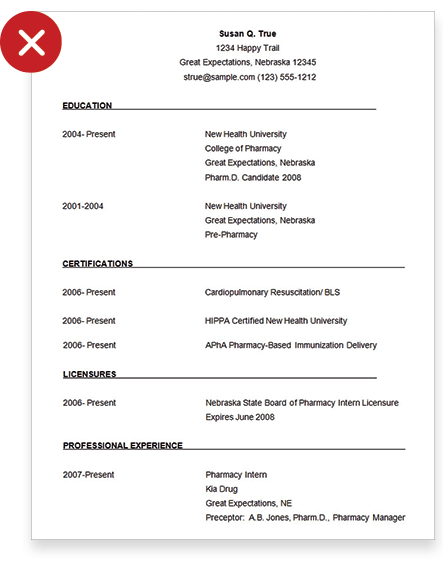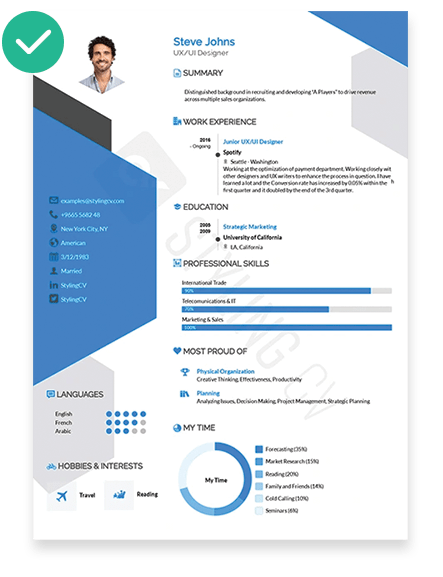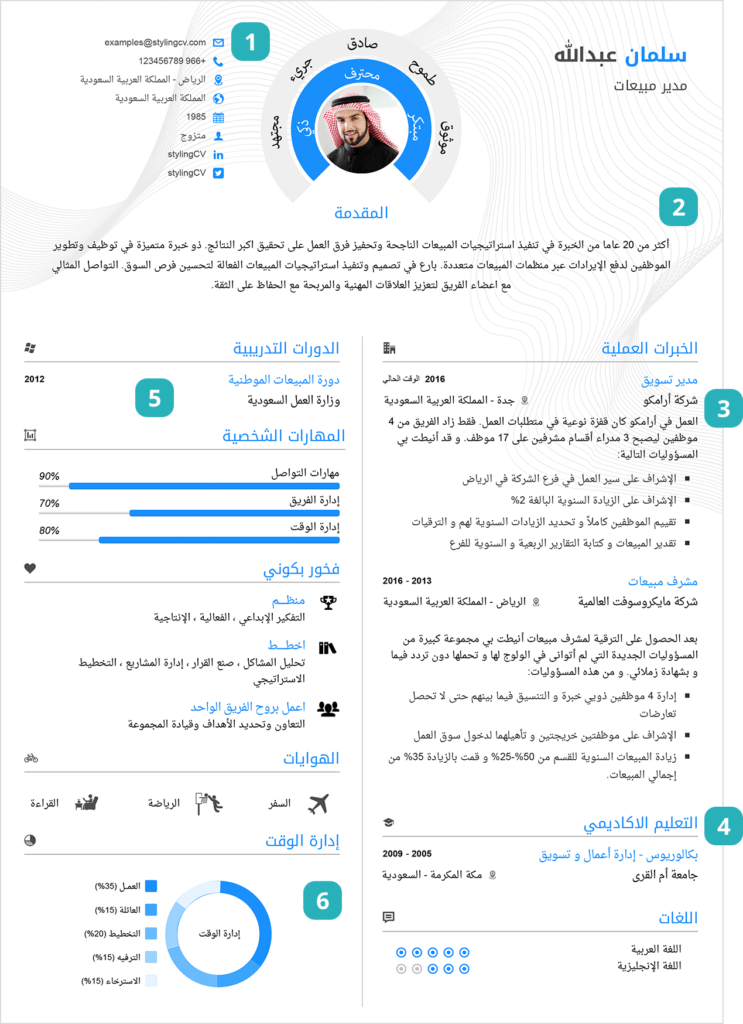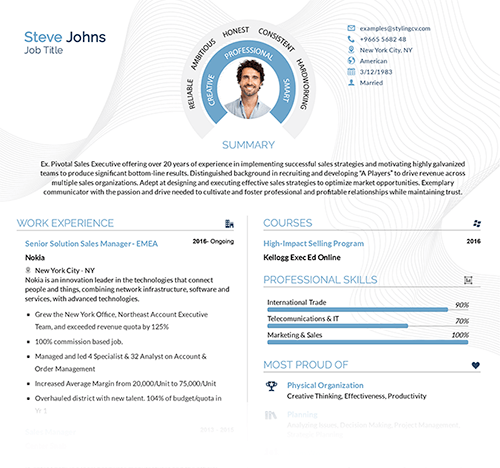
Ce n'est un secret pour personne que décrocher un entretien d'embauche peut être un défi, sans parler de l'obtention du poste lui-même. Mais lorsque vous savez comment rédiger le CV parfait, vous vous donnez quelque chose que les autres candidats n'ont tout simplement pas : une chance ! Grâce à ce guide en 10 étapes, vous pouvez être sur la bonne voie pour décrocher un entretien avec un CV bien conçu, spécialement conçu pour attirer le regard de vos interlocuteurs.
Aide à la rédaction de CV - Votre guide en 10 étapes pour rédiger le CV parfait
Obtenez votre CV gratuit maintenantVotre guide en 10 étapes pour rédiger le CV parfait
Ce n'est un secret pour personne que décrocher un entretien d'embauche peut être un défi, sans parler de l'obtention du poste lui-même. Mais lorsque vous savez comment rédiger le CV parfait, vous vous donnez quelque chose que les autres candidats n'ont tout simplement pas : une chance ! Grâce à ce guide en 10 étapes, vous pouvez être sur la bonne voie pour décrocher un entretien avec un CV bien conçu, spécialement conçu pour attirer le regard de vos interlocuteurs.
Sarah Reynolds
Spécialiste du contenu


Savez-vous comment rédiger le CV parfait ? Cela peut sembler une tâche intimidante, mais ce n'est en fait pas si difficile. Découvrez notre guide en 10 étapes pour rédiger le CV parfait !
Un résumé de ce que vous trouverez dans cet article :
- Apprenez à connaître le CV.
- Les étapes de la rédaction d'un CV sont parfaites.
- Les questions les plus importantes sur la rédaction d'un CV.
- Les conseils les plus importants qui vous aideront à le faire.
Définition du terme "CV"
Que votre carrière soit à peine entamée ou qu'elle dure depuis des années, le curriculum vitae en est un résumé d'environ une page.
Il met en évidence les postes que vous avez occupés et que vous occupez actuellement, les fonctions que vous avez assumées, les talents que vous avez acquis et les qualités qui font de vous un employé de valeur.
Tous ces facteurs se conjuguent pour permettre à n'importe quel responsable du recrutement de constater très facilement vos qualifications et votre aptitude à occuper un poste.
Malgré les efforts que vous avez déployés pour rédiger votre CV, les responsables du recrutement n'y jettent généralement qu'un coup d'œil superficiel, ne lui accordant que quelques secondes de leur temps.
Néanmoins, il est raisonnable de dire qu'il est toujours important de créer un excellent curriculum vitae, plutôt que de le rédiger à la hâte.
En savoir plus : 10 sections essentielles d'un CV
Qu'est-ce qu'un employeur veut voir sur un CV ?
Les responsables de l'embauche recherchent trois éléments dans un curriculum vitae : "Qu'avez-vous fait ? Pourquoi l'avez-vous fait ? Quel a été le résultat ?
Martin McGovern, propriétaire de Career Therapy et consultant en carrière pour Muse, affirme. "Vous serez sur la bonne voie si vous pouvez aborder ces trois questions dans les points de votre CV.
L'objectif est d'utiliser un langage simple et compréhensible, mais la réalité est que la plupart des CV sont illogiques. Ces documents sont truffés de jargon, trop techniques et redondants.
Si vous essayez de lire un CV qui n'est pas le vôtre, vous remarquerez immédiatement qu'il donne l'impression d'avoir été rédigé par un extraterrestre. Prenez l'exemple d'un recruteur qui n'a aucune connaissance des fonctions de votre poste.
Comment rendre votre CV compréhensible pour eux ?
En outre, le responsable du recrutement s'intéresse à vous en relation avec lui plutôt qu'à vous et à vous seul.
Selon Yurovsky, les responsables du recrutement cherchent à déterminer si un candidat "répond aux exigences" du poste à pourvoir.
"Votre curriculum vitae doit présenter cette image afin que le responsable du recrutement sache non seulement quelles sont les tâches quotidiennes que vous êtes capable d'accomplir, mais aussi pourquoi vous, plus que d'autres, représentez une valeur ajoutée pour l'entreprise", explique l'auteur.
Comment rédiger un CV parfait
Voici les 10 principales étapes de la rédaction d'un CV parfait :
1. le bon format fait toute la différence
Nombreux sont ceux qui ne réalisent pas à quel point il est important de choisir le bon format pour leur CV. Traditionnellement, il existe trois formats distincts qui doivent être utilisés :
- Le format chronologique inversé, qui est le plus familier à la plupart des candidats parce qu'il énumère d'abord votre expérience la plus pertinente.
- Il est suivi par le format combiné, qui est excellent pour les professionnels chevronnés qui souhaitent mettre en évidence des compétences pertinentes pouvant être transférées vers une nouvelle carrière.
- Et enfin, le format fonctionnel, qui est entièrement basé sur les compétences.
Il est important de se rappeler que chacun de ces formats présente des avantages et des inconvénients. C'est pourquoi vous devez choisir le format qui convient le mieux à votre expérience, à vos compétences et, surtout, à vos objectifs.
2. N'oubliez pas vos coordonnées
Cela peut surprendre, mais beaucoup trop de candidats négligent d'inclure leurs informations personnelles et leurs coordonnées dans leur CV - c'est une grave erreur !
Mais pourquoi ? Parce que vos interlocuteurs veulent en savoir plus sur vous - autrement qu'en lisant votre expérience sur un bout de papier ou sur leur écran. Par exemple, les coordonnées de base sont indispensables.
Ensuite, vous devez inclure un lien vers votre profil LinkedIn, afin que votre employeur potentiel puisse en savoir plus sur ce que vous pouvez et avez apporté à la table.
Vous pouvez même envisager d'ajouter des liens vers des profils de médias sociaux, votre site web, un blog ou même un portfolio personnel, mais tout cela vient après l'ajout des éléments de base comme votre nom, votre titre, votre adresse postale, votre numéro de téléphone et votre adresse électronique.
N'oublions pas non plus votre profil LinkedIn, car il s'agit d'informations pertinentes pour un employeur potentiel !
3. La rédaction d'un curriculum vitae parfait nécessite un bon résumé et dit tout ce qu'il faut savoir
Le résumé - également connu sous le nom d'intitulé - est un élément important d'un CV bien conçu qu'il ne faut pas négliger.
N'oubliez pas que votre employeur potentiel parcourra les CV plus rapidement que vous ne pouvez parcourir le rouleau d'images de votre téléphone, vous devez donc vous assurer de faire mouche.
Ne vous contentez pas d'énumérer vos tâches quotidiennes. Rédigez des phrases claires, concises et courtes qui énumèrent une à une vos réalisations, votre expérience et vos compétences. Veillez également à éviter le temps de la première personne !
4. Restez pertinent
De nombreux CV ne mentionnent pas ce que l'on appelle l'expérience professionnelle "pertinente".
Au lieu de cela, les candidats énumèrent tous les emplois qu'ils ont occupés, y compris celui qu'ils occupaient au bowling à l'âge de 17 ans.
N'oubliez pas que la personne qui lira votre CV voudra probablement le parcourir en quelques minutes, voire moins. C'est l'occasion de montrer à votre employeur que vous possédez des compétences et une expérience pertinentes susceptibles de l'intéresser.
Voici comment vous devez procéder pour énumérer votre expérience pertinente :
- Titre du poste
- Localisation
- Ligne du temps
- Responsabilités et obligations
- Réalisations et distinctions
- Mots-clés pertinents
Pourquoi les modèles de CV dans MS Word sont-ils MAUVAIS ?

- Il s'agit d'une méthode très ancienne de rédaction d'un CV professionnel et sa création prend beaucoup de temps.
- Chaque fois que vous devez mettre à jour votre CV, le modèle se casse et vous devez tout recommencer.
- Chaque fois que vous voudrez modifier le modèle, vous passerez des heures à essayer de comprendre quelle section va où.

Cela semble simple, non ? N'oubliez pas non plus que lorsque vous ajoutez plusieurs expériences professionnelles à votre CV, vous le faites en respectant le format choisi. Si vous choisissez le format chronologique inversé, vous devez vous assurer de placer le poste le plus récent en premier !

5. Pour rédiger un CV parfait, vous devez simplifier la section relative à la formation
Croyez-le ou non, l'éducation est toujours une zone d'ombre pour de nombreux candidats à l'emploi.
Principalement parce que la manière dont il doit figurer sur votre CV n'est pas assez claire.
Nous aimerions vous simplifier la tâche et faire en sorte qu'il soit plus facile que jamais de mettre en valeur votre travail universitaire de la bonne manière.
Si vous avez obtenu un master, il doit figurer en tête de liste.
Tout le reste doit suivre dans l'ordre chronologique inverse.
Si vous êtes allé à l'université, vous ne devez pas inclure d'informations sur le lycée, car elles ne sont tout simplement pas pertinentes.
À partir de là, vous pouvez ajouter les cours spécialisés que vous avez suivis, les distinctions et les prix que vous avez reçus ou les distinctions honorifiques que vous avez obtenues.
Maintenant, où placer exactement votre section sur l'éducation ?
Cela dépend de votre expérience :
- Si vous êtes à la recherche d'un poste de débutant, vous pouvez placer votre formation au-dessus de votre expérience professionnelle.
- Si vous êtes un professionnel expérimenté, placez-la juste en dessous de votre expérience professionnelle.
6. En rédigeant le CV parfait, vous devez ajouter vos compétences correctes
Il y a une différence entre ce que nous appelons les "hard skills" et les "soft skills".
Compétences spécifiques
Les "hard skills" sont des compétences spécifiques que peu de gens connaissent. Par exemple, vous êtes peut-être un photographe amateur et vous êtes passé maître dans l'utilisation d'Adobe Photoshop.
Il peut s'agir d'une compétence importante qui pourrait distinguer votre candidature des autres - même si elle n'a rien à voir avec la photographie !
Compétences non techniques
Les compétences non techniques, quant à elles, sont des compétences qui s'acquièrent simplement par l'expérience.
Il peut s'agir, par exemple, de compétences en matière d'organisation, de leadership, d'adaptabilité, de communication, etc.
Mais lorsque vous combinez vos compétences et vos aptitudes, vous présentez un ensemble de compétences unique qui intéressera les employeurs potentiels.
Mais n'oubliez pas de toujours ajouter les bonnes compétences, c'est-à-dire de n'ajouter que les compétences pertinentes pour le poste auquel vous postulez.
Ainsi, si vous postulez à un poste de comptable, vos compétences en Photoshop ne sont tout simplement pas pertinentes !
7. Incluez quelques sections supplémentaires importantes dans votre CV
Les CV qui le justifient peuvent toujours bénéficier de sections supplémentaires qui peuvent inclure des éléments tels que vos loisirs, vos centres d'intérêt, tout travail bénévole pertinent que vous avez effectué, des certifications, des récompenses, etc.
Toutefois, cela ne doit être fait que si votre CV le justifie.
Vous pouvez même inclure des informations telles que des publications ou des projets dans lesquels votre nom figure, des langues secondes, des informations sur votre portefeuille, et bien d'autres choses encore.
Tant qu'il est en rapport avec l'emploi auquel vous postulez, il n'y a pas de problème !
Votre réussite commence par un CV

8. Ne négligez pas la lettre de motivation
Tout comme le résumé, la lettre de motivation est indispensable. Or, beaucoup trop de candidats potentiels passent à côté de l'emploi de leurs rêves parce qu'ils sont trop réticents à rédiger une lettre de motivation.
Cet élément d'information essentiel peut être considéré comme votre CV 2.0. Il vous permet de développer votre expérience, de mettre en évidence les réalisations les plus importantes de votre parcours professionnel à ce jour et vous donne l'occasion d'expliquer rapidement et clairement pourquoi vous êtes le candidat le plus qualifié pour un poste.
Et devinez quoi ? Vous pouvez faire tout cela dans des phrases complètes.
9. Relecture Relecture Relecture Relecture de votre CV !
Cela va sans dire, mais veillez toujours à relire votre CV avant de l'enregistrer et de l'envoyer.
Et avant de le faire, demandez à quelqu'un d'autre de le lire et de le relire pour vous.
Vérifiez deux fois l'exactitude de vos informations, utilisez le correcteur orthographique de Microsoft Word, utilisez un logiciel tiers comme Grammarly, ou confiez vos informations à une personne de confiance.
Ne laissez pas passer votre chance de décrocher un entretien à cause d'une virgule mal placée, d'un point oublié ou d'une date incorrecte !
10. Soyez confiant !
La dernière étape de ce guide en 10 étapes pour rédiger le CV parfait est simple : ayez confiance en vous. Si vous avez suivi dans les moindres détails chacune des étapes énumérées ci-dessus, votre dernière tâche consiste à rester confiant en vos capacités, en votre CV et en vous-même pour décrocher l'emploi dont vous avez toujours rêvé.
Lire la suite : Liste des 100 meilleurs mots pour se décrire [Adjectifs et autres]
FAQ sur la rédaction du CV parfait
1-Quelles sont les 5 règles d'or de la rédaction d'un CV ?
Les 5 règles d'or de la rédaction d'un CV
- Le bon format fait toute la différence.
- N'oubliez pas vos coordonnées.
- Restez pertinent.
- Ne laissez pas tomber la lettre de motivation.
2-Qu'est-ce qu'un bon CV en 2022 ?
Nous vous conseillons d'utiliser une structure de CV chronologique inversée dans 99,9 % des cas. C'est le format le plus populaire et le plus pratique en 2022, car les systèmes de suivi des candidatures peuvent facilement le comprendre. Ce format est bien connu des responsables de recrutement et des recruteurs.
3-Qu'est-ce qu'il ne faut pas mettre dans un CV pour 2022 ?
Limitez la quantité d'informations sans rapport avec le poste pour lequel vous postulez. Bien sûr, vous avez des intérêts, des passe-temps, des langues, des chansons préférées et des objectifs, mais limitez à un niveau raisonnable les informations qui ne concernent pas votre capacité à rendre des comptes, à assumer des responsabilités et à travailler dur.
4-Combien de temps votre CV doit-il remonter ?
Pour la majorité des secteurs d'activité, les conseillers d'orientation professionnelle et les experts en rédaction de CV vous conseillent de vous concentrer sur les 10 à 15 dernières années. (Certains postes, comme ceux du gouvernement fédéral ou du monde universitaire, exigent souvent des historiques de carrière plus complets).
Styling CV offre toutes les solutions pour votre CV, et dans la section blog vous trouverez divers articles sur la façon de construire un CV avec de nombreux conseils et instructions.
Inscrivez-vous dès maintenant et bénéficiez de nombreux avantages en termes de construction de CV et d'accès à divers modèles.
Articles connexes
Tags
Créez votre CV en 10 minutes
Utilisez des modèles de CV professionnels testés sur le terrain qui respectent les "règles du CV" exactes que les employeurs recherchent. Créer mon CV
CRÉER MON CV MAINTENANT




